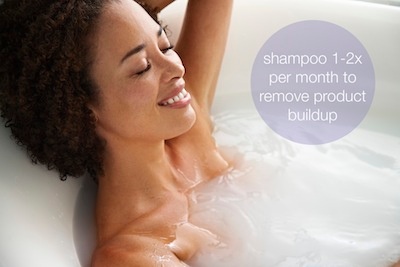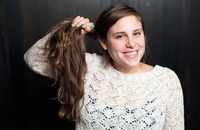
Lather. Rinse. Repeat. Washing your hair is one of life’s most pedestrian tasks, one that you’d think most people would know how to do as adults. But if you’re lathering the entire length of your hair and repeating that process every 1–2 days, then heads up: you’re probably doing it wrong.
We talked to San Francisco stylist (and hair-trend forecaster) Kristina Louise Welzien about how to wash your hair like a pro, including the best practices for sudsing longer strands.
First, figure out your hair type—but not on your own.
You might think that you already know your hair type, but it’s not always as obvious as it seems. Kristina specializes in highly textured hair, and notes that two women with the same curl pattern might have completely different weights to their hair. She recommends asking your stylist or barber to be sure, as your hair type will help determine your washing process.
If your hair is oily to normal …

“That’s the most common scenario, that the ends of the hair are typically much drier [than the roots] and therefore they need special care. But at the same time, people want that fresh, clean feeling at the scalp,” Kristina said.
In this case, you should take a dab of shampoo and massage it lightly into your scalp. You don’t generally need to pull shampoo through your entire head of hair—as the lather rinses down, that’ll be enough to cleanse the length.
You’ll want to do the opposite with your conditioner: apply it from the midshaft down, using a formula that supports curls or color if necessary. “[Not putting conditioner on the top of your head] will support the scalp from becoming oily throughout the day,” Kristina said.
If your hair is highly textured or very dry …

Hair that’s very curly, particularly black hair, can go much longer without being washed. “Maybe shampoo once a month as a nice way to clarify the scalp from buildup of product,” Kristina said. “Otherwise, there’s really no shampooing that’s going on, and it’s all about the conditioning of the scalp and hair.”
Just conditioning might seem like it would weigh your hair down, but the simple act of rinsing actually removes a lot of oil. “Any time you get the hair wet, you’re drying it out,” Kristina said. If you’re still feeling too greasy, though, you could try throwing in an apple cider vinegar rinse every once in awhile. It dissolves oil, is color-safe, and helps balance hair’s pH levels.
Speaking of color: Kristina stressed that those who don’t color or heat-style their hair are hardly immune to dryness. “From the ponytail down, that hair’s been around for awhile, so it always needs conditioning.”

Don’t lather up at the first sign of oil. Seriously, resist.
You might think that you’re doing yourself a favor by keeping your scalp oil-free, but that approach can actually be counterproductive. “If we use anything that’s too astringent or too cleansing and we use it too often, it can actually have a reverse effect where [hair] can get very dried out,” Kristina said. “This can actually produce more oil in the long run. Then you have this combination of really dry and really oily together, which are two characteristics that are really hard to battle at the same time.”
Learning to live with your oil isn’t enough—you should learn to love it. “There’s not a hair mask or deep conditioner on the market that is as great as our own natural oil,” Kristina said.
Hungry for more hair knowledge?













